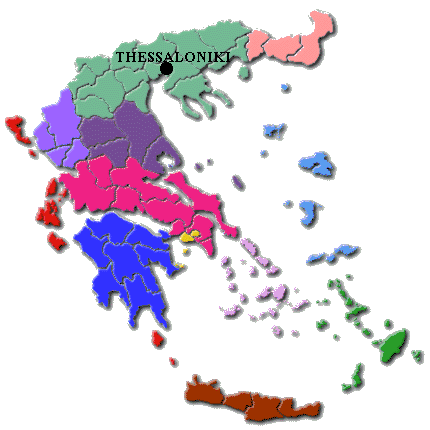 Thessaloniki
Thessaloniki
|
|

Thessaloniki is the second largest city of Greece and it is one of the ancient cities in Europe. It was founded at about 315 B.C. by Kassandros, the king of Macedonia. Kassandros gave to the city the name of his wife Thessaloniki who was sister of Alexander the Great. Since then, Thessaloniki, has become the chief city of Macedonia and its most important commercial port. In Roman times it was visited by Saint Paul, who preached the new religion. In Byzantine times, Thessaloniki became a cultural and artistic center second only to Constantinople in the whole Empire. Great names are associated with Thessaloniki' s Byzantine past. After the fall of Thessaloniki (1430) and despite the unfavorable conditions prevailing during the Turkish occupation, there were Greek schools that struggled to preserve the Greek language and literature until the city was liberated on October 26, 1912, the anniversary of the patron saint, St. Demetrius. In the nineteenth century the long scholarly tradition of the city was continued with many well known historians, archaeologists, philologists etc.

Today Thessaloniki with its University and the International Trade Fair - a crossroad for peoples' friendship and collaboration- is a lively modern city bustling with life and movement. Thessaloniki is one of the most important trade and communication centers in the Mediterranean.
Old houses, neoclassical buildings, modern dwellings. Yesterday meets today at old taverns, "ouzeries", restaurants, hotels, luxury bars, dance halls, cinema halls, theatres e.t.c. The most important problems of the midtown are the traffic jam and the few parking lots.
After the lively city, a different world: The Upper City (Ano-Poli), full of poetry and charm. Old neighborhoods with narrow streets and lovely small gardens. Yards with clothes-lines and children playing to the streets.
Aristotle University of Thessaloniki was founded in 1925 during the First Greek Republic. The University originally consisted of five schools Theology, Philosophy, Law and Economics, Physics and Mathematics, and Medicine. The number of enrolled students is about 56.000 in 35 faculties that cover the full range of scientific disciplines (some of which are unique in Greece). The teaching and research staff consists today of over 2.400 members while the special technical and administrative personnel is about 2.000. Due to its size and structure is the largest Greek institution of higher education.
Our school is located in Stavroupoli municipality, in the area of Ilioupoli. Stavroupoli is one of the biggest municipalities at the west side of the city.
Additional information about Thessaloniki:
http://www.vacation.net.gr/p/thess_ab.html